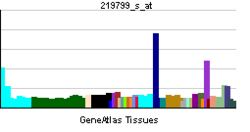- DHRS9
-
Dehydrogenase/reductase SDR family member 9 is an enzyme that in humans is encoded by the DHRS9 gene.[1][2][3][4]
References
- ^ Soref CM, Di YP, Hayden L, Zhao YH, Satre MA, Wu R (Jun 2001). "Characterization of a novel airway epithelial cell-specific short chain alcohol dehydrogenase/reductase gene whose expression is up-regulated by retinoids and is involved in the metabolism of retinol". J Biol Chem 276 (26): 24194–202. doi:10.1074/jbc.M100332200. PMID 11304534.
- ^ Chetyrkin SV, Belyaeva OV, Gough WH, Kedishvili NY (Jun 2001). "Characterization of a novel type of human microsomal 3alpha -hydroxysteroid dehydrogenase: unique tissue distribution and catalytic properties". J Biol Chem 276 (25): 22278–86. doi:10.1074/jbc.M102076200. PMID 11294878.
- ^ Persson B, Kallberg Y, Bray JE, Bruford E, Dellaporta SL, Favia AD, Duarte RG, Jornvall H, Kavanagh KL, Kedishvili N, Kisiela M, Maser E, Mindnich R, Orchard S, Penning TM, Thornton JM, Adamski J, Oppermann U (Feb 2009). "The SDR (short-chain dehydrogenase/reductase and related enzymes) nomenclature initiative". Chem Biol Interact 178 (1-3): 94–8. doi:10.1016/j.cbi.2008.10.040. PMC 2896744. PMID 19027726. http://www.pubmedcentral.nih.gov/articlerender.fcgi?tool=pmcentrez&artid=2896744.
- ^ "Entrez Gene: DHRS9 dehydrogenase/reductase (SDR family) member 9". http://www.ncbi.nlm.nih.gov/sites/entrez?Db=gene&Cmd=ShowDetailView&TermToSearch=10170.
Further reading
- Haeseleer F, Palczewski K (2000). "Short-chain dehydrogenases/reductases in retina.". Meth. Enzymol. 316: 372–83. doi:10.1016/S0076-6879(00)16736-9. PMID 10800688.
- Strausberg RL, Feingold EA, Grouse LH, et al. (2003). "Generation and initial analysis of more than 15,000 full-length human and mouse cDNA sequences.". Proc. Natl. Acad. Sci. U.S.A. 99 (26): 16899–903. doi:10.1073/pnas.242603899. PMC 139241. PMID 12477932. http://www.pubmedcentral.nih.gov/articlerender.fcgi?tool=pmcentrez&artid=139241.
- Markova NG, Pinkas-Sarafova A, Karaman-Jurukovska N, et al. (2003). "Expression pattern and biochemical characteristics of a major epidermal retinol dehydrogenase.". Mol. Genet. Metab. 78 (2): 119–35. doi:10.1016/S1096-7192(02)00226-3. PMID 12618084.
- Clark HF, Gurney AL, Abaya E, et al. (2003). "The secreted protein discovery initiative (SPDI), a large-scale effort to identify novel human secreted and transmembrane proteins: a bioinformatics assessment.". Genome Res. 13 (10): 2265–70. doi:10.1101/gr.1293003. PMC 403697. PMID 12975309. http://www.pubmedcentral.nih.gov/articlerender.fcgi?tool=pmcentrez&artid=403697.
- Jette C, Peterson PW, Sandoval IT, et al. (2004). "The tumor suppressor adenomatous polyposis coli and caudal related homeodomain protein regulate expression of retinol dehydrogenase L.". J. Biol. Chem. 279 (33): 34397–405. doi:10.1074/jbc.M314021200. PMID 15190067.
- Gerhard DS, Wagner L, Feingold EA, et al. (2004). "The status, quality, and expansion of the NIH full-length cDNA project: the Mammalian Gene Collection (MGC).". Genome Res. 14 (10B): 2121–7. doi:10.1101/gr.2596504. PMC 528928. PMID 15489334. http://www.pubmedcentral.nih.gov/articlerender.fcgi?tool=pmcentrez&artid=528928.
- Jones RJ, Dickerson S, Bhende PM, et al. (2007). "Epstein-Barr virus lytic infection induces retinoic acid-responsive genes through induction of a retinol-metabolizing enzyme, DHRS9.". J. Biol. Chem. 282 (11): 8317–24. doi:10.1074/jbc.M608667200. PMID 17244623.
Categories:- Human proteins
- Chromosome 2 gene stubs
Wikimedia Foundation. 2010.

